Hypothesis
Decentralized publishing of Creative Commons licensed NFT book not only helps information dissemination but also balances the interests of authors, publishers, and bookstores.
Design
- License my new work Moneyverse: How money works in the multiverse in CC-BY and publish it in a decentralized manner.
- “Decentralized” is reflected in three aspects:
- independent publishing without applying for an ISBN or other applications
- direct sales by the author, not relying on individual digital platforms or chain stores
- storage based on peer-to-peer and blockchain technology, preventing tampering or censorship
- Priced at USD 9.9, with a goal to sell 1,000 copies during the experiment period.
- Sell directly through my blog, bookstores, websites, and social media, accepting payment via credit card or prepaid card.
- Provide traceable links to distribution channels, sharing 30% of the revenue.
- Direct sales through my blog will also share 30% of the revenue.
- Remaining income is allocated for the author (myself in this case. 20%), curator (20%), designer (10%), editor (10%), and technical support (10%).
- Free distribution of epub and pdf files is allowed.
- Owners of the original versions receive an NFT as a certificate, including a unique cover, author’s autograph and personalized message, and a link to the text.
Timeline
- 2022.10.27: Release preview version, open for pre-order
- 2022.11.03: Blocktrend publishes “Redefining publishing with NFT”
- 2022.11.04: Explain the decentralized publishing experiment with an FAQ, encouraging distribution channels to join
- 2022.11.11: Release the preface “I don’t invest” and officially launch sales
- 2022.11.15: FAB DAO Discord Ask Me Anything promotion event
- 2022.11.19: dAb and Friends podcast interview on “Owning My First NFT Book” is broadcasted
- 2022.11.22: Taipei Tech Blockchain Club “Web3 and universal access of knowledge” community class
- 2022.11.23: Nowhere Ximen Bookstore Moneyverse promotion event
- 2022.11.25: HK Reader Bookstore Moneyverse promotion event
- 2022.11.26: Social Enterprise Summit “Metaversal Good – Edu x Art x Tech”
- 2022.11.30: Sales end
Sales
- Original copies (NFT) sold: 1,024
- Rewards for past supporters: 239
- Total circulation: 1,263
The 34-day sales period is divided into two stages: 14 days of pre-order and 20 days of official sales, with 466 copies sold in the former and 558 in the latter.
In addition, the author took this opportunity to reward 239 readers who had supported him in the past through paid subscriptions or purchasing single articles with cryptocurrency (Writing NFT) with the new book, but the related income was not included in this experiment. Including the rewards, the total circulation of the Moneyverse NFT book is 1,263 copies.
The following is the daily sales, click-through rate, and conversion rate of the direct sales channel, i.e., the author’s blog ckxpress.com.

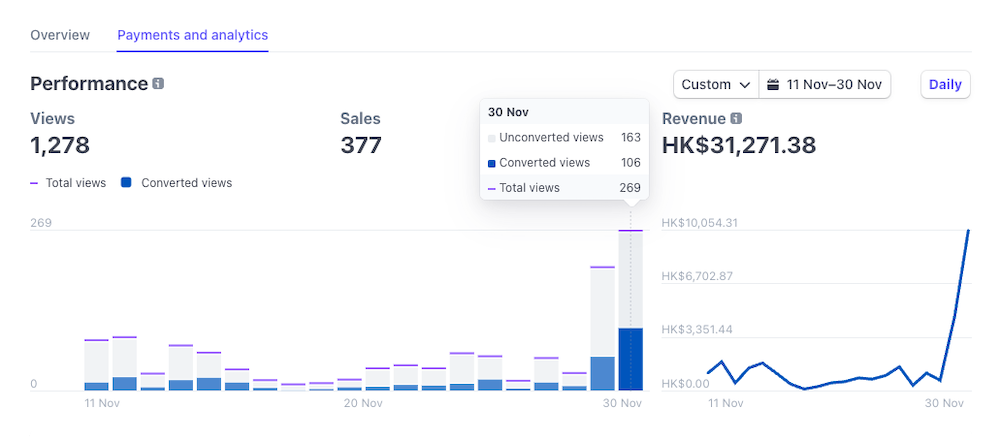
Revenue
- Sales revenue: $10,138 (USD, same below), i.e., 1,024 x 9.9
- Credit card channel and exchange rate costs: $847, i.e., 1,024 x 0.827, 8.4%
- Advertising expenses: $0
- Total revenue: $9,291, i.e., 1,024 x 9.073
- Author’s income (royalties + direct sales channel share): $4,080
- Publisher’s income (curation, design, editing, technical support share): $4,645
- Distribution channel share: $566
The credit card channel and exchange rate costs, accounting for 8.4% of the sales revenue, are relatively high. However, when publishing other books, increasing the price or avoiding foreign exchange would reduce the proportion of these costs.
According to the pre-agreed consensus, the income is allocated according to the established proportions for royalties (20%), curation (20%), designers (10%), editors (10%), and technical support (10%):
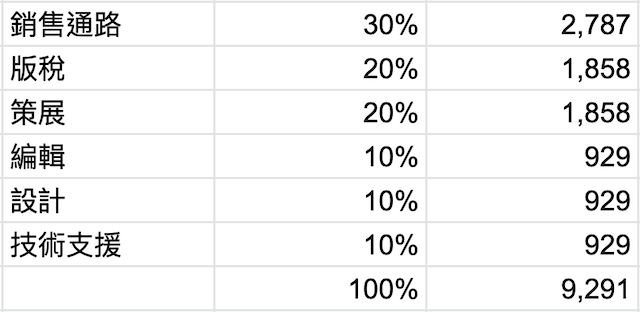
Since the internet has broken media monopolies, authors can reach readers through various forms such as newsletters and social media, and can also sell books directly. Therefore, in the decentralized publishing model, the author can play two roles, receiving not only the 20% “royalty” but also a 30% share of the direct sales channel. In this experiment, direct sales accounted for 79.7% (see the next section “Channels”).
Additionally, if the traditional publisher’s role is divided into curation, editing, design, and technical support, the actual share for the publisher in a decentralized publishing model is 50%.
Following this logic, the author’s income comes from royalties and the direct sales channel share, while the publisher’s income comes from the shares of the four roles: curation, editing, design, and technical support.
After reorganizing, the income distribution is shown in the following chart:
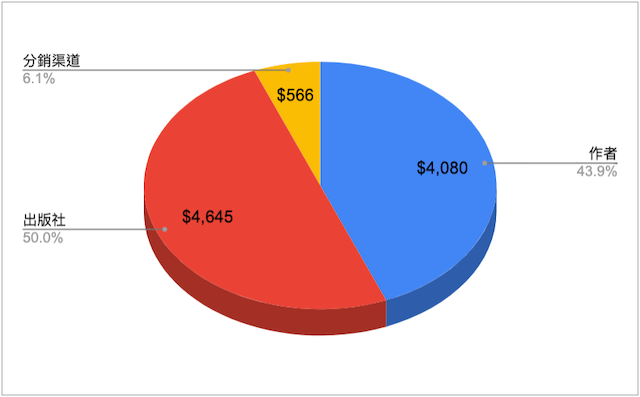
As a benchmark for reference, my work The Sociology of Blockchain: Reimagining Money, Media and Democracy was published in a traditional format. From July 1, 2020, to June 30, 2022, a total of 2,047 paper books were sold, generating revenue of $26,369 (HKD 205,675), and author royalties of $2,122 (HKD 16,548). The sales volume of the ebook is unknown, with royalties of $205 (HKD 1,598). Library compensation royalties were $3.2 (HKD 25). In addition, the income of the publisher and channels, as well as printing costs, are unknown.
Distribution channels
- Participating channels: 21
- Highest sales volume: 62 copies
- Lowest sales volume: 1 copy
- Distribution channel share: 20.3%
Ebook sales have always been oligopolized by a few platforms, with traditional bookstores holding on to paper books and standing in opposition to ebooks. This decentralized publishing experiment also attempts to break this long-standing situation.
Considering that this publication only needed to collect enough data for analysis and that manpower was extremely tight, the experiment did not fully deploy distribution channels. Instead, it experimentally invited two independent bookstores, one in Taiwan and one in Hong Kong, to participate in the distribution as demonstrations. Additionally, media outlets such as BlockTempo, dAb and Friends, BrainBro, and Fintect Dark War also played the role of “ebookstores” in the experiment.
After the plan was announced, some bookstores and readers expressed interest in participating, and they were all included. Among them, a Taipei East Gate-based store called Chun Liang Society placed a mooInk reader in the store with the epub ebook displayed for readers to try out and purchase by scanning a QR code. Although the numbers have not yet shown significant results, it has demonstrated more possibilities for independent bookstores.
In the end, direct sales channels accounted for nearly 80%. Among the distribution channels, Blocktrend had the highest sales volume, reaching 62 copies. Traditional independent bookstore HK Reader sold 22 copies. Considering the low overlap between the book’s subject matter and HK Reader’s target audience, as well as the short sales period, this figure can be considered satisfactory. Most importantly, the case proves that traditional bookstores can also play the role of ebook distributors, receive the same share as paper book sales, and do so without managing inventory or occupying a large amount of space.
If sales were not time-limited and the distribution network was fully deployed, it is believed that the distribution share and total sales volume would both increase.

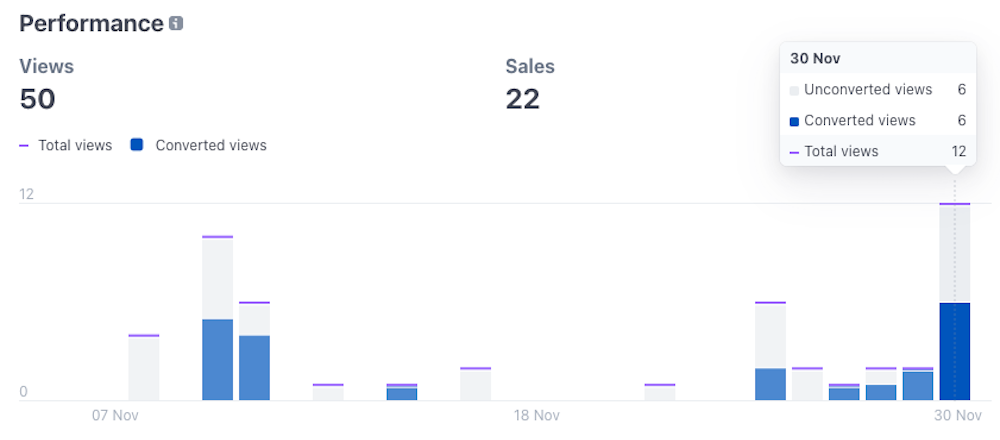
Participants
- Number of buyers: 943
- Regions: 18
- Highest single purchase: 21
- Average purchase per person: 1.09 copies
- Average spending per person: 10.79 USD
- Number of refunds: 0
Since readers do not need to provide an address and the system does not record the source IP address, the source regions of the participants are based on the location of the credit card.
Among them, the highest single purchase was made by the channel “Fintech Dark War” itself. Since the sales period had already ended when the video was released, the channel decided to buy 20 copies of inventory and distribute them on their own after the experiment.
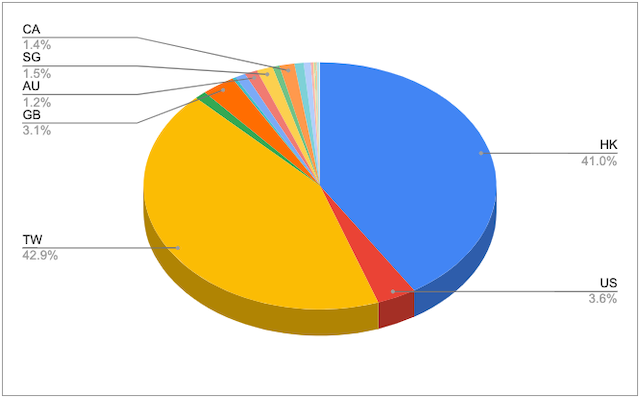
Downloads
This book is licensed in CC-BY 4.0, allowing anyone to freely share it. Therefore, the download numbers above only include the official webpage’s statistics. As of noon on December 7, 2022, the official webpage downloads alone have far exceeded the sales of the authentic version, with the actual numbers unknown.
Conclusion
Without considering the printing factory, logistics, and property owners, the publication of Moneyverse: How money works in the multiverse prioritizes the protection of the interests of authors and the publishing industry. It not only allows authors, editors, designers, curators, distributors and technical support personnel to receive a fair share but also allows readers to contribute and obtain what they need according to their abilities. Those who can afford it pay for the original copy with NFT, while those in need download the free pdf/ePub to gain access to knowledge.
In summary, this experiment successfully proves that decentralized publishing of Creative Commons licensed NFT books not only helps information dissemination but also takes into account the interests of the industry.


Leave a Reply